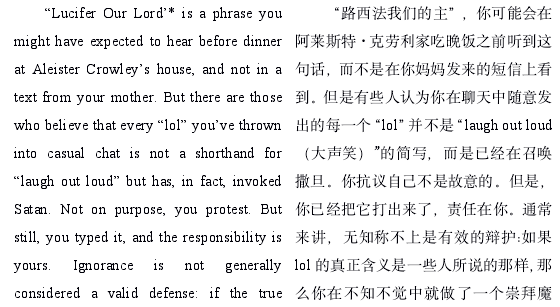联系方式
more本类最新英语论文
- 2024-04-20基于语料库的企业简介英译中..
- 2024-04-08纪录片《大国崛起》第四集模..
- 2024-04-03《古埃及人的风俗习惯》(第..
- 2024-01-27中国特色政治词汉英译名问题..
- 2023-11-09《推进发展中国家税收征管数..
- 2023-09-28《塑料汤:海洋污染图集》(..
- 2023-07-25《电动汽车充电桩安装调试与..
- 2023-07-21《电动汽车结构·原理·检测..
- 2023-07-15《发电用柴油机使用手册》英..
- 2023-06-22关联理论语境视角下的汉英博..
more热门文章
- 2009-03-31商务英语毕业论文范文
- 2009-04-02中西广告文化差异与翻译
- 2014-05-11论商标翻译与美学-on trade..
- 2014-05-26商务英语的语言特征及翻译原..
- 2009-04-02商标的文化特征及翻译策略
- 2009-03-17商务英语翻译理论原则与特点
- 2009-04-07英文商标名称的汉译
- 2015-02-07商务礼仪之问候礼节研究ess..
- 2009-08-05论商务英语委婉语的表达和翻..
- 2009-08-05国际商务英语信函的文体特点..
more留学论文写作指导
- 2024-03-31卡森•麦卡勒斯小说中..
- 2024-03-28美国黑人女性心理创伤思考—..
- 2024-03-27乔治·艾略特《织工马南》中..
- 2024-03-21超越凝视:论《看不见的人》..
- 2024-03-19《哈克贝利•费恩历险..
- 2024-03-13心灵救赎之旅——从凯利的三..
- 2024-02-22文学地理学视角下的《印度之..
- 2023-05-03英、汉名词短语之形容词修饰..
- 2023-02-07目的论视域下5g—the futur..
- 2022-07-04二语英语和三语日语学习者的..
目的论指导下的英语复杂句翻译实践报告——以《一个字都别信》(节选)为例 [4]
论文作者:留学生论文论文属性:硕士毕业论文 dissertation登出时间:2021-11-01编辑:vicky点击率:3018
论文字数:43566论文编号:org202110141757433205语种:英语 English地区:中国价格:$ 44
关键词:商务英语论文
摘要:本文是一篇商务英语论文翻译,在目的论及其三原则的指导下,作者分析了《不相信一个词》中的20个长句和复杂句的例子,主要运用了五种翻译技巧:顺序、倒装、转换、转移和综合性语义。众所周知,英语句子以主语和谓语为核心,主体结构突出。内容中的其他从属关系和修饰关系围绕着这个主体。
Justa Holz Mantari developed the theory of Vermeer. In her own theory, the word“translation” broke the traditional connotation and she emphasized that we should make adistinction between translation and translation behavior (Zhang, 2004). Besides, Mantariproposed translation behavior theory by adopting communication and behavior theory.

商务英语论文翻译
................................
Chapter Five Conclusion
Under the guidance of Skopos theory and its three principles, the author analyses 20examples of long and complex sentences in Don’t Believe A Word, mainly using fivetranslation techniques: sequencing, inversion, conversion, diversion and comprehensivestrategies.
As we all know, English sentences take the subject and predicate as the core, and themain structure is prominent. Other subordination and modification relations in thesentence surround this main body. The entire compound sentence structure is a “grapebunch” structure. Therefore, the logical relationship of each component is very clear; inthe form of expression, English mostly uses conjunctions, prepositions, participle phrases,and various clauses and long sentences derived from relative pronouns and relativeadverbs. In contrast, Chinese emphasizes the meaning of sentences, and the sentences aremostly stated item by item in chronological order and the whole sentence structure is in a“bamboo” structure. Therefore, the semantic relationship of Chinese sentences isrelatively implicit. In the form of expression, Chinese mainly uses verbs to form severalshort sentences that seem to have a parallel relationship.
Thus, translators need to use some translation techniques when facing long andcomplex sentences. In the process of translating, the author finds that sequencing can beused when there are the same logical and order between English and Chinese. It is anideal technique that can reproduce the content and style of the original text to themaximum extent. Sometimes the structure of long and complex sentences in English isopposite to that of Chinese. It is necessary to translate from the back of the originalEnglish so that the structure of the sentence is more in line with the expression habits ofChinese. Generally speaking, there are many cases in which English long and complexsentences do not conform to Chinese habits, so the inversion technique is used morefrequently. Chinese is dynamic so that verbs are dominant in Chinese expression. WhileEnglish is static, using fewer verbs, and a large number of concepts that should beexpressed by verbs will be expressed by nouns. There are many other cases. For example,certain prepositions and adjectives in English can be translated into verbs in Chinese.
reference(omitted)

 英国
英国 澳大利亚
澳大利亚 美国
美国 加拿大
加拿大 新西兰
新西兰 新加坡
新加坡 香港
香港 日本
日本 韩国
韩国 法国
法国 德国
德国 爱尔兰
爱尔兰 瑞士
瑞士 荷兰
荷兰 俄罗斯
俄罗斯 西班牙
西班牙 马来西亚
马来西亚 南非
南非






